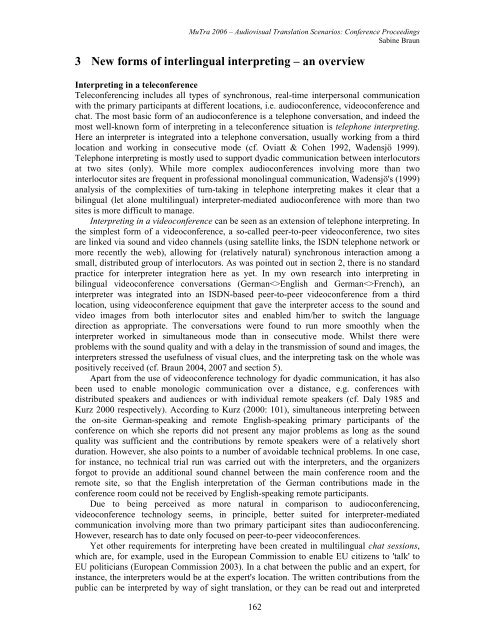Proceedings - Translation Concepts
Proceedings - Translation Concepts
Proceedings - Translation Concepts
You also want an ePaper? Increase the reach of your titles
YUMPU automatically turns print PDFs into web optimized ePapers that Google loves.
MuTra 2006 – Audiovisual <strong>Translation</strong> Scenarios: Conference <strong>Proceedings</strong><br />
Sabine Braun<br />
3 New forms of interlingual interpreting – an overview<br />
Interpreting in a teleconference<br />
Teleconferencing includes all types of synchronous, real-time interpersonal communication<br />
with the primary participants at different locations, i.e. audioconference, videoconference and<br />
chat. The most basic form of an audioconference is a telephone conversation, and indeed the<br />
most well-known form of interpreting in a teleconference situation is telephone interpreting.<br />
Here an interpreter is integrated into a telephone conversation, usually working from a third<br />
location and working in consecutive mode (cf. Oviatt & Cohen 1992, Wadensjö 1999).<br />
Telephone interpreting is mostly used to support dyadic communication between interlocutors<br />
at two sites (only). While more complex audioconferences involving more than two<br />
interlocutor sites are frequent in professional monolingual communication, Wadensjö's (1999)<br />
analysis of the complexities of turn-taking in telephone interpreting makes it clear that a<br />
bilingual (let alone multilingual) interpreter-mediated audioconference with more than two<br />
sites is more difficult to manage.<br />
Interpreting in a videoconference can be seen as an extension of telephone interpreting. In<br />
the simplest form of a videoconference, a so-called peer-to-peer videoconference, two sites<br />
are linked via sound and video channels (using satellite links, the ISDN telephone network or<br />
more recently the web), allowing for (relatively natural) synchronous interaction among a<br />
small, distributed group of interlocutors. As was pointed out in section 2, there is no standard<br />
practice for interpreter integration here as yet. In my own research into interpreting in<br />
bilingual videoconference conversations (GermanEnglish and GermanFrench), an<br />
interpreter was integrated into an ISDN-based peer-to-peer videoconference from a third<br />
location, using videoconference equipment that gave the interpreter access to the sound and<br />
video images from both interlocutor sites and enabled him/her to switch the language<br />
direction as appropriate. The conversations were found to run more smoothly when the<br />
interpreter worked in simultaneous mode than in consecutive mode. Whilst there were<br />
problems with the sound quality and with a delay in the transmission of sound and images, the<br />
interpreters stressed the usefulness of visual clues, and the interpreting task on the whole was<br />
positively received (cf. Braun 2004, 2007 and section 5).<br />
Apart from the use of videoconference technology for dyadic communication, it has also<br />
been used to enable monologic communication over a distance, e.g. conferences with<br />
distributed speakers and audiences or with individual remote speakers (cf. Daly 1985 and<br />
Kurz 2000 respectively). According to Kurz (2000: 101), simultaneous interpreting between<br />
the on-site German-speaking and remote English-speaking primary participants of the<br />
conference on which she reports did not present any major problems as long as the sound<br />
quality was sufficient and the contributions by remote speakers were of a relatively short<br />
duration. However, she also points to a number of avoidable technical problems. In one case,<br />
for instance, no technical trial run was carried out with the interpreters, and the organizers<br />
forgot to provide an additional sound channel between the main conference room and the<br />
remote site, so that the English interpretation of the German contributions made in the<br />
conference room could not be received by English-speaking remote participants.<br />
Due to being perceived as more natural in comparison to audioconferencing,<br />
videoconference technology seems, in principle, better suited for interpreter-mediated<br />
communication involving more than two primary participant sites than audioconferencing.<br />
However, research has to date only focused on peer-to-peer videoconferences.<br />
Yet other requirements for interpreting have been created in multilingual chat sessions,<br />
which are, for example, used in the European Commission to enable EU citizens to 'talk' to<br />
EU politicians (European Commission 2003). In a chat between the public and an expert, for<br />
instance, the interpreters would be at the expert's location. The written contributions from the<br />
public can be interpreted by way of sight translation, or they can be read out and interpreted<br />
162
















